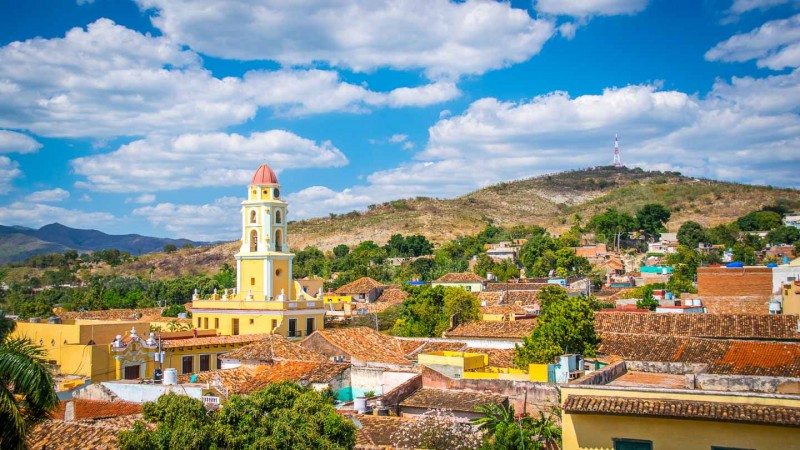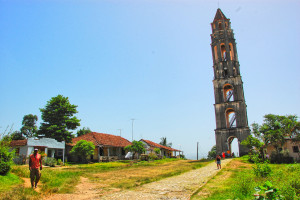TRINIDAD CITY, CUBA. BEAUTIFUL AND HISTORIC.
Trinidad was founded on December 23, 1514 by Diego Velázquez de Cuéllar under the name Villa De la Santísima Trinidad. A town in the province of Sancti Spíritus, central Cuba.
Together with the nearby Valley of the Sugar Mill (Valle de los Ingenios),it has been one of UNESCOs World Heritage sites since 1988. The valley had around 70 long-standing sugar mills which are reminder of the importance of sugar to the Cuban economy over the centuries. Although most of the sugar mills are in ruins, intact structures endure at some sites, including Guachinango, where the plantation house remains, and the plantation of Manaca Iznaga, where the owner’s house, a tower and some barracones, the original slave quarters, still stand. Although the barracones are now used as housing and are in poor repair, the house (which has been converted into a restaurant) and the “Iznaga Tower” are well maintained. The 45 metre (147 ft) tower was constructed sometime in 1816 by the owner, Alejo Maria Iznaga y Borrell. According to experts, the bell that formerly hung on top of the tower announced the beginning and the end of the work day for the slaves, as well as the times for prayers to the Holy Virgin in the morning, midday and afternoon.
It was also used to sound an alarm in case of fire or slave escape. The height and magnificence of the tower served to display Iznaga’s power over his slaves and his stature in the sugar industry and local society; at one time it was the tallest structure in Cuba. A recognised landmark of the region, the Iznaga Tower testifies to the area’s flourishing material culture in the Spanish colonial period. The large bell now rests at the foot of the tower. Francisco Iznaga, a rich Basque landowner in the southern portion of Cuba during the first 30 years of the colonization of Cuba, was elected Mayor of Bayamo in 1540. Iznaga was the originator of a powerful lineage that finally settled in Trinidad where the Torre Iznaga is. A 45 meter tower built by Alejo Iznaga Borrell in 1816. The Iznaga family and his descendants fought for the Independence of Cuba from 1820 to 1900. Trinidad is one of the best preserved cities in the Caribbean from the time when the sugar trade was the main industry in the region
UNESCO declared Trinidad (the third Spanish settlement in Cuba) to be a part of world cultural heritage because of its colonial architecture, which dates from the 18th, 19th and early 20th centuries. The oldest part of the city (55 blocks in size, with 1211 buildings). In 2004, the municipality of Trinidad had a population of 73,466. With a total area of 1,155 km2 (446 sq mi), it has a population density of 63.6 /km2 (165 /sq mi).
The municipality is divided into the barrios of Primero, Segundo, Tercero, Aguacate, Cabagán, Caracusey, Casilda, Guaniquical, Río de Ay, San Francisco, San Pedro and Táyaba.
Twenty km from the city is Topes de Collantes, one of Cuba’s premier ecotourism centers, built during Pres. Batista government. Topes de Collantes is a nature reserve park in the Escambray Mountains range in Cuba. It also refers to the third highest peak in the reserve, where a small settlement and tourist center is located, all sharing the same name. Topes de Collantes, literally Collantes’ Highs, almost 800 metres (2,600 ft) above sea level, along with Potrerillo peak, 931 metres (3,054 ft) and tallest San Juan peak, 1,140 metres (3,740 ft) are located in the Escambray range.
These mountains are shared by the three central provinces of the island; Villa Clara Province to the north, Cienfuegos Province and Sancti Spiritus Province to the east and west respectively. The wet winds coming off the Atlantic Ocean have made the north face of the mountains a luxurious refugee for plants and animals, while the drier south face hosts important ecosystems.
It contains beautiful churches (such as the Great Parish Church, a neoclassical edifice built in 1892) and public squares, the most important of which is Main Square-surrounded by buildings of great beauty and historic and architectural interest and considered the second most important square in the country, after Havana’s Cathedral Square.
Agencies/Wiki/Internet Photos/Youtube/Arnoldo Varona/TheCubanHistory.com
THE CUBAN HISTORY, HOLLYWOOD.
FOLLOW US ON TWITTER AND FACEBOOK. THECUBANHISTORY.COM
LA CIUDAD DE TRINIDAD, CUBA. BELLA E HISTORICA.
Trinidad fue fundada el 23 de diciembre 1514 por Diego Velázquez de Cuéllar con el nombre de Villa de la Santísima Trinidad. Es una ciudad en la provincia de Sancti Spíritus, región central de Cuba.
Junto con el cercano Valle de la Fábrica de Azúcar (Valle de los Ingenios), ha sido uno de la Unesco de Patrimonio de la Humanidad desde 1988. El valle tenía alrededor de 70 ingenios azucareros de larga data que son recordatorio de la importancia del azúcar para la economía cubana a través de los siglos. Aunque la mayoría de los ingenios azucareros están en ruinas, las estructuras intactas soportar en algunos sitios, entre ellos Guachinango, donde la casa de la plantación se mantiene, y la plantación de Manaca Iznaga, donde la casa del propietario, una torre y barracones algunos, los barracones de los esclavos originales, todavía ponerse de pie. A pesar de los barracones ahora se utilizan como vivienda y se encuentran en mal estado, la casa (que se ha convertido en un restaurante) y la “Torre Iznaga” están bien mantenidos. El de 45 metros (147 pies) de la torre fue construida en algún momento de 1816 por el propietario, Alejo Iznaga y Borrell, María. Según los expertos, la campana que antes colgaba en la parte superior de la torre, anunció el inicio y el final de la jornada de trabajo de los esclavos, así como los tiempos para la oración a la Santísima Virgen en la mañana, mediodía y tarde.
También fue utilizado para hacer sonar una alarma en caso de incendio o fuga de esclavos. La altura y magnificencia de la torre sirvió para mostrar el poder Iznaga sobre sus esclavos y su estatura en la industria azucarera y de la sociedad local, a la vez que era la estructura más alta de Cuba. Un hito reconocido de la región, la Torre Iznaga da testimonio de la cultura material de la zona floreciente en la época colonial española. La gran campana ahora descansa a los pies de la torre. Francisco Iznaga, un rico terrateniente vasco en la porción sur de Cuba durante los primeros 30 años de la colonización de Cuba, fue elegido alcalde de Bayamo en 1540. Iznaga fue el origen de un linaje de gran alcance que finalmente se estableció en Trinidad, donde la Torre Iznaga es. Una torre de 45 metros construido por Alejo Iznaga Borrell en 1816. La familia Iznaga y sus descendientes lucharon por la Independencia de Cuba desde 1820 hasta 1900. Trinidad es una de las ciudades mejor preservadas en el Caribe desde el momento en que el comercio de azúcar fue la principal industria en la región
UNESCO declaró a Trinidad (el tercer asentamiento español en Cuba) para ser parte del patrimonio cultural mundial por su arquitectura colonial, que data de los siglos 18, 19 y 20. La parte más antigua de la ciudad (55 bloques de tamaño, con 1211 edificios). En 2004, el municipio de Trinidad tenía una población de 73.466. Con una superficie total de 1.155 km2 (446 millas cuadradas), tiene una densidad poblacional de 63,6 / km 2 (165 / millas cuadradas).
El municipio se divide en los barrios de Primero, Segundo, Tercero, Aguacate, Cabagan, Caracusey, Casilda, Guaniquical, Río de Ay, San Francisco, San Pedro y Tayaba.
Veinte kilómetros de la ciudad es Topes de Collantes, uno de los principales centros de turismo ecológico de Cuba, construido durante el gobierno del Pres. Batista. Topes de Collantes es un parque de reserva natural en la sierra del Escambray en Cuba. También se refiere a la tercera montaña más alta en la reserva, donde se encuentra un pequeño poblado y centro turístico, que comparten el mismo nombre. Topes de Collantes, literalmente Altísimos Collantes “, casi 800 metros (2.600 pies) sobre el nivel del mar, junto con el pico de Potrerillo, 931 metros (3.054 pies) y el más alto pico de San Juan, 1.140 metros (3.740 pies) se encuentran en la Sierra del Escambray.
Estas montañas son compartidos por las tres provincias centrales de la isla, provincia de Villa Clara, al norte, la provincia de Cienfuegos y Sancti Spíritus, al este y oeste respectivamente. Los vientos húmedos procedentes del Océano Atlántico han hecho de la cara norte de las montañas de un refugiado de lujo para las plantas y animales, mientras que la cara más seca al sur alberga importantes ecosistemas.
Contiene bellas iglesias (como la gran iglesia parroquial, un edificio neoclásico construido en 1892) y plazas públicas, el más importante de lo que es la plaza principal, rodeada de edificios de gran belleza e interés histórico y arquitectónico y considerada la segunda plaza más importante en el país, después de la Plaza de la Catedral de La Habana.
Agencies/Wiki/Internet Photos/Youtube/Arnoldo Varona/TheCubanHistory.com
THE CUBAN HISTORY, HOLLYWOOD.









